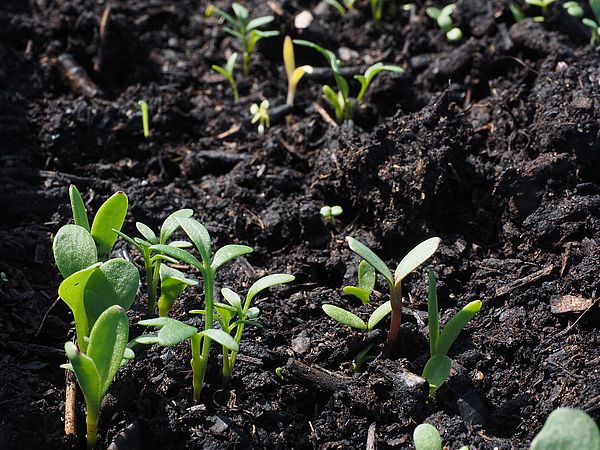Soil isn’t just the dirt we might think of when we wash our hands or take our shoes off at the door. Healthy soil is alive – it’s full of layered root systems, microbial communities, organic matter, worms, bugs, and fungi. It’s an entire ecosystem that powers all life above it. It can sequester carbon, hold water, and support healthy plant life – all of which are vital to turning the tide on climate change. And, most importantly for Lake Champlain’s water quality, soil with just a 1% increase in organic matter in the top six inches can hold over 20,000 gallons of water per acre.
This ability to hold more water is due to the organic soil’s tendency to clump together, which opens air pockets and makes the ground more porous. Deeper, longer roots also do their part to open channels for the water to trickle down, and increase the biologic activity deeper in the earth. To visually illustrate the differences between healthy and unhealthy soil, you can do a quick experiment with a pile of flour and a few slices of bread. When water is sprinkled over the flour, simulating rain, it immediately runs off. The inside of the flour pile remains dry, while “floodwaters” pool around it, full of murky sediment. On the other hand, water sprinkled over bread is easily absorbed. The bread can hold many times more water than the flour, and it will retain much of that moisture during dry conditions. The bread, representing healthy soil, is flour (sediment) with the addition of yeast (biologic activity), sugar (nutrients in organic matter), and water. It is porous, absorbent, and resistant to erosion.
Why is this important for water quality? When water filters down through the soil, instead of traveling along its surface, many pollutants have the chance to settle out. Excess phosphorus and nitrogen integrate into the soil where they are absorbed by plants, instead of turning water bodies green with an overgrowth of algae, weeds, and cyanobacteria. Bacteria from animal waste can be broken down by soil microbes, instead of flowing into the rivers and lakes where we recreate and get our drinking water. Soil that can’t easily absorb water is more susceptible to both flooding and drought.
The good news is that restoring soil health can be straightforward enough for anyone to do! The first step is adding organic matter – you can do this by top-dressing with compost, leaving fallen leaves and grass clippings on the ground, and waiting to trim back your garden until the spring. With the increased organic matter in your soil you can maximize the diversity of plants on your land, paying particular attention to varying root lengths and growth seasons. Diversity above ground will be reflected in diversity below ground. Minimize bare soil and keep photosynthesis going for as long as possible – this will draw carbon dioxide and water into the soil, and keep life cycles going. However, a few patches of bare soil can provide habitat for certain insects, like native bees, so don’t eliminate them completely!
As your plants grow, minimize disturbance to the soil. Allow the roots, fungi, and microbes to form a network of organic activity, and avoid breaking this network apart by tilling or compacting the air pockets microbes need to breathe. One extreme example of the danger of soil disturbance is the Dust Bowl of the 1930s, where improper tilling, overgrazing, and the removal of native grasses eroded the soil into dust. However, not all disturbance is bad – bringing some animals back into contact with the soil can restore soil productivity. In grasslands this might mean strategically grazing cows, sheep, or other herd animals, with long periods of rest between grazes. In urban areas it’s more likely that rabbits will be trimming the plants and replenishing the soil with their pellets.
Soil is the skin of our planet. It acts as a holding tank for floodwater, a filter for pollutants, and a source of life for all growing things. It’s vital to protect and cultivate healthy soils, from large farms and forests to small gardens and city parks.
